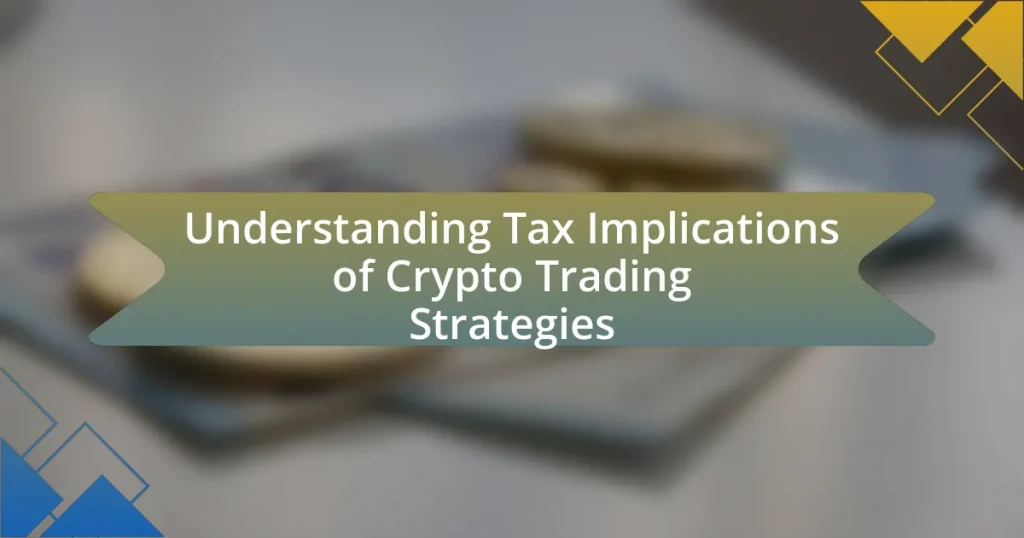The article focuses on analyzing the correlation between Bitcoin and altcoin prices, highlighting the generally positive relationship where altcoin prices tend to rise alongside Bitcoin’s price increases. It defines correlation in the context of cryptocurrency, explains statistical methods used to measure it, and distinguishes between correlation and causation. The article emphasizes the importance of understanding this correlation for investment strategies, discusses the risks associated with investing in correlated assets, and outlines factors influencing the correlation, such as market sentiment and liquidity. Additionally, it provides insights into how investors can analyze these correlations using various tools and methodologies while cautioning against common pitfalls in correlation analysis.

What is the correlation between Bitcoin and Altcoin prices?
The correlation between Bitcoin and Altcoin prices is generally positive, meaning that when Bitcoin’s price increases, Altcoin prices tend to rise as well. This relationship is often attributed to Bitcoin’s dominance in the cryptocurrency market, where it serves as a benchmark for other cryptocurrencies. Historical data shows that during significant price movements of Bitcoin, such as the bull market of 2017, many Altcoins experienced substantial gains, reflecting their dependence on Bitcoin’s market trends. Additionally, research indicates that Bitcoin’s market capitalization influences Altcoin performance, with a correlation coefficient often exceeding 0.7 during bullish phases, suggesting a strong relationship between the two.
How is correlation defined in the context of cryptocurrency prices?
Correlation in the context of cryptocurrency prices is defined as a statistical measure that indicates the extent to which the price movements of two cryptocurrencies, such as Bitcoin and altcoins, are related. This relationship is quantified using correlation coefficients, which range from -1 to 1; a coefficient close to 1 indicates a strong positive correlation, meaning that as one cryptocurrency’s price increases, the other’s tends to increase as well, while a coefficient close to -1 indicates a strong negative correlation, where one price increases as the other decreases. For example, historical data has shown that Bitcoin often exhibits a positive correlation with major altcoins, particularly during market rallies, as evidenced by various analyses that track price movements over time.
What statistical methods are used to measure correlation?
Statistical methods used to measure correlation include Pearson’s correlation coefficient, Spearman’s rank correlation coefficient, and Kendall’s tau coefficient. Pearson’s correlation coefficient quantifies the linear relationship between two continuous variables, providing a value between -1 and 1, where 1 indicates a perfect positive correlation, -1 indicates a perfect negative correlation, and 0 indicates no correlation. Spearman’s rank correlation coefficient assesses the strength and direction of the association between two ranked variables, making it suitable for non-parametric data. Kendall’s tau coefficient measures the ordinal association between two variables, focusing on the ranks of the data rather than their actual values. These methods are widely utilized in financial analysis, including studies on the correlation between Bitcoin and altcoin prices, to determine how closely related their price movements are.
How does correlation differ from causation in cryptocurrency markets?
Correlation in cryptocurrency markets indicates a statistical relationship between two variables, such as Bitcoin and altcoin prices, where movements in one may coincide with movements in the other. However, causation implies that one variable directly influences the other, establishing a cause-and-effect relationship. For instance, while Bitcoin’s price increase may correlate with a rise in altcoin prices, it does not necessarily mean that Bitcoin’s performance causes the altcoins to rise; other factors, such as market sentiment or external economic conditions, could be influencing both simultaneously. This distinction is crucial for investors, as relying solely on correlation without understanding causation can lead to misguided investment decisions.
Why is understanding this correlation important for investors?
Understanding the correlation between Bitcoin and altcoin prices is crucial for investors because it influences investment strategies and risk management. When Bitcoin experiences price fluctuations, altcoins often follow suit due to their interconnected market dynamics. For instance, historical data shows that during Bitcoin’s price surges, altcoins typically see increased trading volumes and price appreciation, as observed in the 2017 cryptocurrency boom. This correlation allows investors to make informed decisions about portfolio diversification and timing of trades, ultimately impacting their potential returns and risk exposure.
What risks are associated with investing in correlated assets?
Investing in correlated assets carries the risk of amplified losses during market downturns. When assets are highly correlated, they tend to move in the same direction, meaning that if one asset declines in value, the others are likely to follow suit. For example, during the 2018 cryptocurrency market crash, both Bitcoin and numerous altcoins experienced significant declines simultaneously, highlighting the risk of reduced diversification benefits. This correlation can lead to a lack of protection against market volatility, as investors may find their portfolios losing value across multiple holdings at once.
How can correlation analysis inform investment strategies?
Correlation analysis can inform investment strategies by identifying relationships between asset prices, enabling investors to optimize their portfolios. For instance, if Bitcoin and a specific altcoin exhibit a strong positive correlation, an investor may choose to allocate funds to both assets to capitalize on their simultaneous price movements. Historical data shows that during market rallies, Bitcoin often leads altcoin price increases, suggesting that monitoring Bitcoin’s performance can provide insights into potential altcoin investments. This strategic approach allows investors to mitigate risks and enhance returns by making informed decisions based on the observed correlations.

What factors influence the correlation between Bitcoin and Altcoin prices?
The correlation between Bitcoin and Altcoin prices is primarily influenced by market sentiment, liquidity, and Bitcoin’s dominance in the cryptocurrency market. Market sentiment drives investor behavior; when Bitcoin experiences significant price movements, it often leads to similar reactions in Altcoin prices due to traders’ perceptions of Bitcoin as a market leader. Liquidity affects how easily assets can be bought or sold without impacting their price; higher liquidity in Bitcoin typically results in more stable price movements, which can influence Altcoin prices. Additionally, Bitcoin’s market dominance, which has historically hovered around 40-60%, serves as a benchmark for Altcoins, often leading to correlated price movements during market trends. Historical data shows that during bullish phases, Altcoins tend to rise in tandem with Bitcoin, while in bearish phases, they often decline alongside it, reinforcing the correlation.
How do market trends affect the correlation?
Market trends significantly influence the correlation between Bitcoin and altcoin prices by altering investor sentiment and market dynamics. When Bitcoin experiences a bullish trend, it often leads to increased investment in altcoins, resulting in a positive correlation as both asset classes rise in value. Conversely, during bearish market trends, altcoins may decouple from Bitcoin, leading to a negative or weaker correlation as investors seek to minimize losses. Historical data from 2020 to 2021 shows that during Bitcoin’s price surge, altcoins like Ethereum and Litecoin also saw substantial gains, indicating a strong correlation during that period. This correlation can be quantified through statistical measures such as Pearson’s correlation coefficient, which demonstrated values close to 0.8 during bullish phases, reflecting a strong relationship between the price movements of Bitcoin and altcoins.
What role does market sentiment play in price movements?
Market sentiment significantly influences price movements by affecting traders’ perceptions and behaviors. When sentiment is positive, it often leads to increased buying activity, driving prices up, as seen during Bitcoin’s price surge in late 2017 when optimism about cryptocurrency adoption peaked. Conversely, negative sentiment can trigger selling pressure, resulting in price declines, exemplified by the market downturn in early 2018 following regulatory concerns. This correlation between sentiment and price movements is supported by studies indicating that sentiment analysis can predict market trends, highlighting its critical role in financial markets.
How do macroeconomic factors impact cryptocurrency correlations?
Macroeconomic factors significantly impact cryptocurrency correlations by influencing investor sentiment and market dynamics. For instance, changes in interest rates can affect the attractiveness of cryptocurrencies compared to traditional assets; lower interest rates may lead to increased investment in cryptocurrencies as investors seek higher returns. Additionally, economic indicators such as inflation rates and GDP growth can alter perceptions of risk and stability, leading to shifts in how cryptocurrencies correlate with each other and with traditional financial markets. Historical data shows that during periods of economic uncertainty, such as the 2020 COVID-19 pandemic, cryptocurrencies exhibited increased correlation with equities, reflecting a flight to riskier assets.
What is the impact of Bitcoin’s price volatility on Altcoin prices?
Bitcoin’s price volatility significantly impacts Altcoin prices, often leading to correlated price movements. When Bitcoin experiences sharp price fluctuations, Altcoins typically react by either following Bitcoin’s trend or amplifying the volatility. For instance, during Bitcoin’s rapid price increases, many Altcoins tend to rise as investors seek to capitalize on the overall bullish sentiment in the cryptocurrency market. Conversely, when Bitcoin’s price drops sharply, Altcoins often suffer larger percentage losses due to panic selling and reduced investor confidence. Historical data shows that during major Bitcoin price swings, such as the 2017 bull run and subsequent corrections, Altcoin prices exhibited similar patterns, reinforcing the correlation between Bitcoin’s volatility and Altcoin market behavior.
How do sudden price changes in Bitcoin affect Altcoin markets?
Sudden price changes in Bitcoin significantly impact Altcoin markets, often leading to correlated price movements. When Bitcoin experiences a sharp increase or decrease in value, Altcoins typically follow suit, either rising or falling in tandem. This correlation is largely due to Bitcoin’s dominance in the cryptocurrency market, which historically accounts for over 40% of the total market capitalization. For instance, during the Bitcoin price surge in late 2017, many Altcoins also saw substantial gains, reflecting a strong positive correlation. Conversely, when Bitcoin’s price dropped sharply in early 2018, Altcoins experienced significant declines as well, demonstrating the sensitivity of Altcoin markets to Bitcoin’s volatility.
What historical events have demonstrated this impact?
The historical events that have demonstrated the impact of Bitcoin on altcoin prices include the 2017 cryptocurrency market boom and the 2020 DeFi surge. During the 2017 boom, Bitcoin’s price skyrocketed from around $1,000 in January to nearly $20,000 in December, leading to a significant increase in altcoin prices, with many altcoins achieving all-time highs. This correlation was evidenced by the rise of Ethereum, which increased from approximately $8 to over $1,400 in the same period. Similarly, in 2020, as Bitcoin’s price approached $20,000 again, the DeFi sector experienced explosive growth, with altcoins like Chainlink and Uniswap seeing price increases of over 1,000%, illustrating Bitcoin’s influence on the broader cryptocurrency market.

How can investors analyze the correlation between Bitcoin and Altcoin prices?
Investors can analyze the correlation between Bitcoin and Altcoin prices by utilizing statistical methods such as Pearson correlation coefficients and regression analysis. These methods quantify the degree to which the price movements of Bitcoin and various Altcoins are related over a specific time period. For instance, historical data from cryptocurrency exchanges can be collected and analyzed to determine the correlation coefficient, which ranges from -1 to 1, indicating perfect negative to perfect positive correlation, respectively. Studies have shown that Bitcoin often leads market trends, with many Altcoins exhibiting a strong positive correlation, particularly during bullish market phases, as evidenced by data from CoinMarketCap and various academic research papers on cryptocurrency market dynamics.
What tools and resources are available for correlation analysis?
For correlation analysis, tools and resources include statistical software such as R, Python libraries like Pandas and NumPy, and platforms like Excel and SPSS. R provides extensive packages for statistical analysis, while Python’s libraries facilitate data manipulation and visualization, making them suitable for analyzing relationships between Bitcoin and altcoin prices. Excel offers built-in functions for correlation calculations, and SPSS is widely used in social sciences for advanced statistical analysis. These tools are validated by their widespread use in academic research and industry applications, ensuring reliability in correlation analysis.
How can investors use technical analysis to assess correlation?
Investors can use technical analysis to assess correlation by analyzing price movements and patterns between Bitcoin and altcoins through tools such as correlation coefficients and chart overlays. The correlation coefficient quantifies the degree to which two assets move in relation to each other, with values ranging from -1 to 1; a value close to 1 indicates a strong positive correlation, while a value close to -1 indicates a strong negative correlation. For example, during periods of market volatility, investors may observe that altcoin prices often move in tandem with Bitcoin, suggesting a correlation that can be quantified using historical price data. By employing moving averages and trend lines on price charts, investors can visually assess the relationship and identify potential trading opportunities based on correlated movements.
What role do data analytics platforms play in this analysis?
Data analytics platforms are essential in analyzing the correlation between Bitcoin and altcoin prices as they provide tools for data collection, processing, and visualization. These platforms enable researchers to aggregate vast amounts of cryptocurrency market data, apply statistical methods, and identify patterns or trends that reveal the relationship between Bitcoin and altcoin price movements. For instance, platforms like Tableau or Python libraries such as Pandas facilitate the manipulation of time-series data, allowing analysts to compute correlation coefficients that quantify the strength and direction of the relationship. This analytical capability is crucial for making informed investment decisions and understanding market dynamics.
What common mistakes should investors avoid when analyzing correlation?
Investors should avoid assuming that correlation implies causation when analyzing correlation. This mistake can lead to incorrect conclusions about the relationship between Bitcoin and altcoin prices. For instance, a high correlation between Bitcoin and an altcoin does not mean that changes in Bitcoin prices cause changes in the altcoin prices; both may be influenced by external factors such as market sentiment or regulatory news. Additionally, investors often overlook the importance of timeframes, as correlations can vary significantly over different periods, leading to misleading interpretations. Lastly, failing to consider the impact of outliers can distort correlation analysis, as extreme price movements can skew results and create a false sense of stability in the relationship.
How can over-reliance on correlation lead to poor investment decisions?
Over-reliance on correlation can lead to poor investment decisions by creating a false sense of security regarding asset performance. Investors may assume that a strong correlation between Bitcoin and altcoin prices guarantees similar future movements, neglecting other critical factors such as market fundamentals, regulatory changes, or technological developments. For instance, during the 2018 cryptocurrency market downturn, many investors who relied solely on the correlation between Bitcoin and altcoins suffered significant losses, as altcoins did not follow Bitcoin’s recovery trajectory. This illustrates that correlation does not imply causation, and failing to consider broader market dynamics can result in misguided investment strategies.
What are the limitations of correlation analysis in cryptocurrency?
Correlation analysis in cryptocurrency has several limitations, primarily due to the volatile nature of the market. First, correlation does not imply causation; high correlation between Bitcoin and altcoin prices may not indicate that one directly influences the other. Additionally, the cryptocurrency market is influenced by numerous external factors, such as regulatory changes, technological advancements, and market sentiment, which can distort correlation results. Furthermore, the presence of outliers can significantly affect correlation coefficients, leading to misleading interpretations. Lastly, the time frame of the analysis can yield different correlation results; short-term correlations may differ from long-term trends, complicating the analysis further. These factors collectively limit the reliability of correlation analysis in understanding the dynamics between Bitcoin and altcoin prices.
What best practices should investors follow when analyzing Bitcoin and Altcoin correlations?
Investors should utilize statistical analysis, such as correlation coefficients, to assess the relationship between Bitcoin and Altcoin prices. This method quantifies the degree to which the prices move together, providing insights into market dynamics. For instance, a correlation coefficient close to 1 indicates a strong positive correlation, while a value near -1 suggests an inverse relationship. Historical data analysis reveals that Bitcoin often leads market trends, influencing Altcoin movements; for example, during the 2017 bull run, many Altcoins followed Bitcoin’s price trajectory closely. Additionally, investors should monitor market sentiment and news events, as these factors can significantly impact correlations. By combining statistical analysis with qualitative insights, investors can make informed decisions regarding their Altcoin investments relative to Bitcoin.















